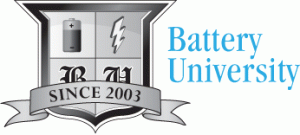Definitive Info on Lithium Battery
How to Prolong Lithium-based Batteries

How to Prolong Lithium-based Batteries
The lithium-ion battery works on ion movement between the positive and negative electrodes. In theory such a mechanism should work forever, but cycling, elevated temperature and aging decrease the performance over time. Since batteries are used in demanding environmental conditions, manufacturers take a conservative approach and specify the life of most Li-ion between 300 and 500 discharge/charge cycles.
Counting cycles is not conclusive because a discharge may vary in depth and there are no clearly defined standards of what constitutes a cycle. Read more about What Constitutes a Discharge Cycle?. In lieu of cycle count, some batteries in industrial instruments are date-stamped, but this method is not reliable either because it ignores environmental conditions. A battery may fail within the allotted time due to heavy use or unfavorable temperature conditions, but most quality packs will last considerably longer than what the stamp indicates.
The performance of a battery is measured in capacity, a leading health indicator. Internal resistance and self-discharge also play a role but with modern Li-ion these carry lower significance in predicting the end-of-battery-life. Figure 1 illustrates the capacity drop of 11 Li-polymer batteries that have been cycled at a Cadex laboratory. The 1500mAh pouch cells for smartphones were first charged at a current of 1500mA (1C) to 4.20V/cell and allowed to saturate to 0.05C (75mA) as part of the full charge procedure. The batteries were then discharged at 1500mA to 3.0V/cell, and the cycle was repeated.
Figure 1: Capacity drop as part of cycling
A pool of new 1500mAh Li-ionbatteries for smartphones is tested on a Cadex C7400 battery analyzer. All 11 pouch packs show a starting capacity of 88–94 percent and decrease in capacity to 73–84 percent after 250 full discharge cycles (2010).
Article source: http://www.batteryuniversity.com/learn/article/how_to_prolong_lithium_based_batteries
Lithium Batteries Fall under 2 Goups
 In spite of the various chemical variations, lithium-ion batteries can generally be separated into two groups: lithium iron phosphate (LFP, LiFePO4) and metal oxides (NCM, NCA, Cobalt, Manganese). Table 1outlines the differences between the two chemistry classes on a cell level. The values in the table reflect average values as there is variation in each class.
In spite of the various chemical variations, lithium-ion batteries can generally be separated into two groups: lithium iron phosphate (LFP, LiFePO4) and metal oxides (NCM, NCA, Cobalt, Manganese). Table 1outlines the differences between the two chemistry classes on a cell level. The values in the table reflect average values as there is variation in each class.
All lithium-ion cells are “deep cycle” meaning that they have the ability to be fully charged and discharged. The life of the battery will significantly increase if the depth of each discharge is limited to 80% of the rated capacity.